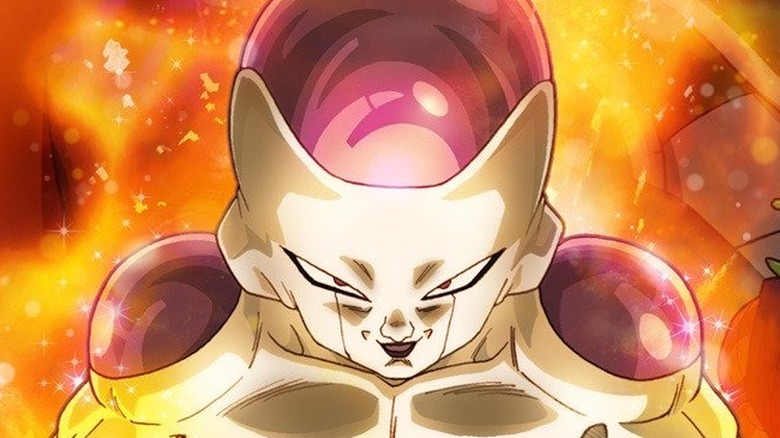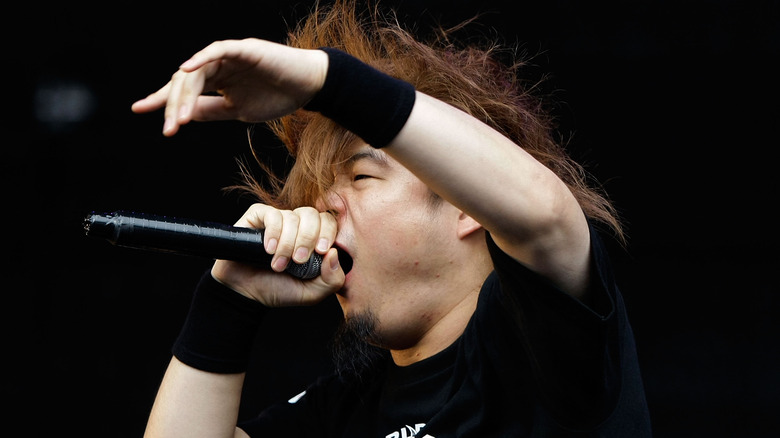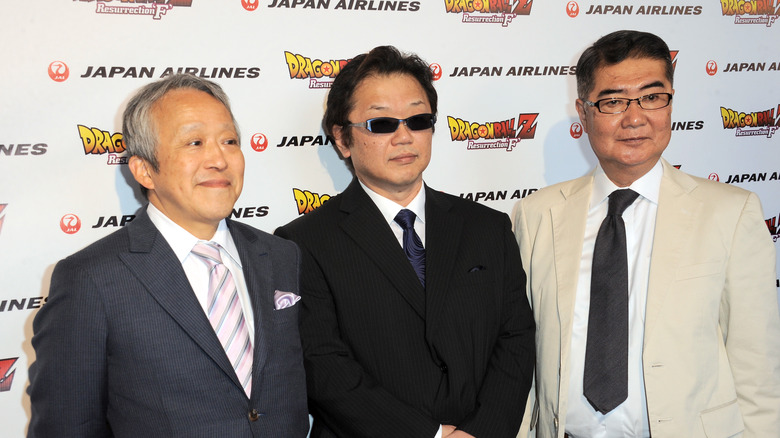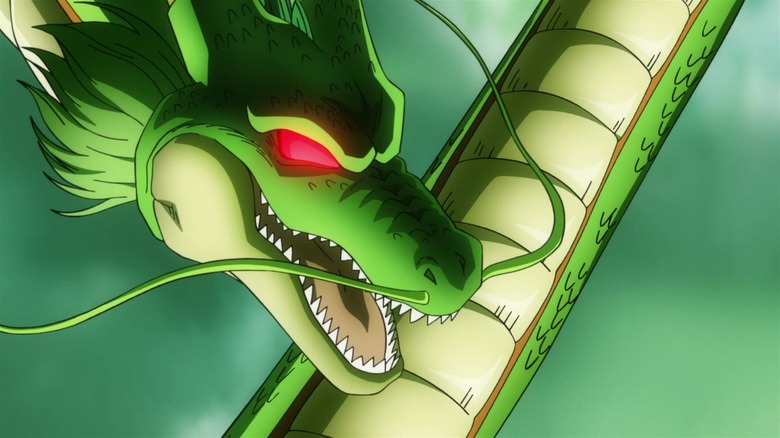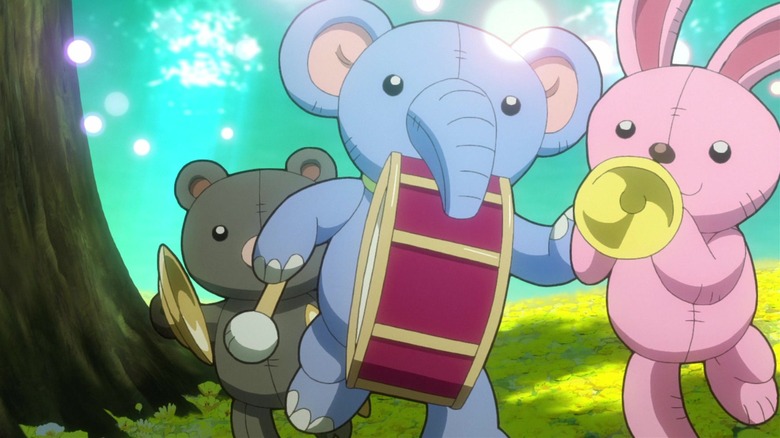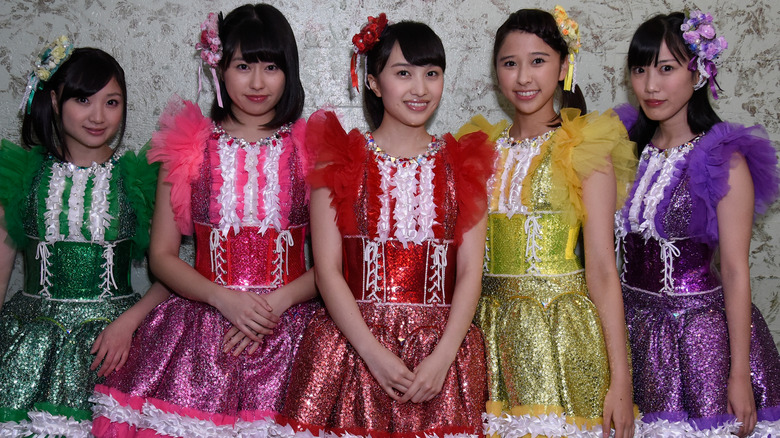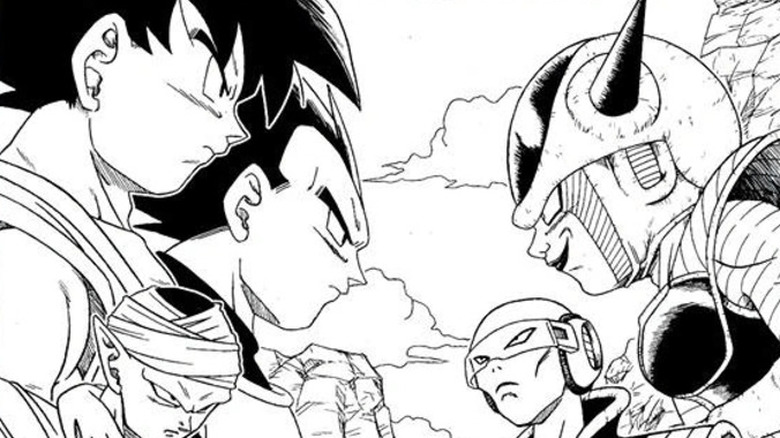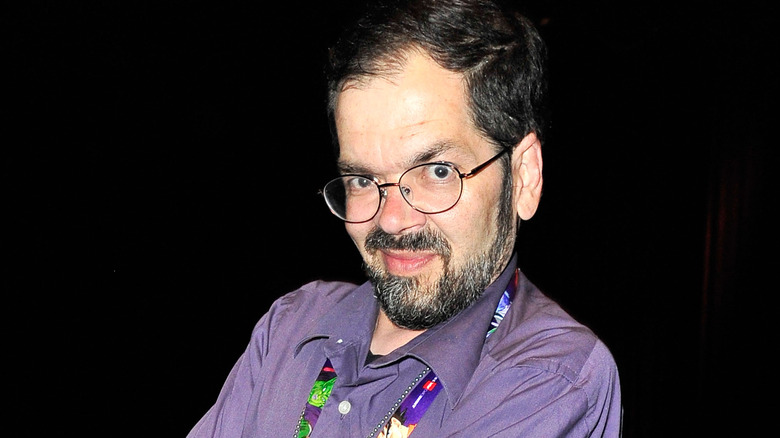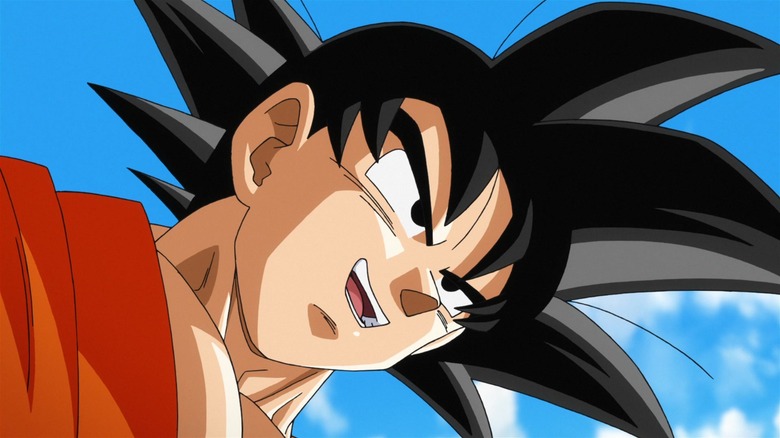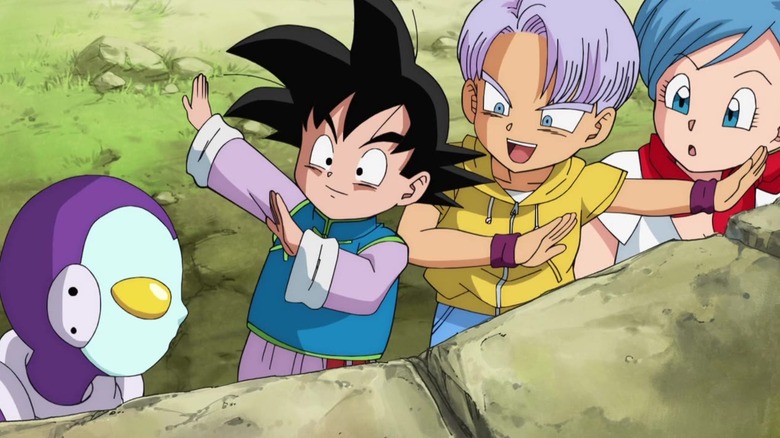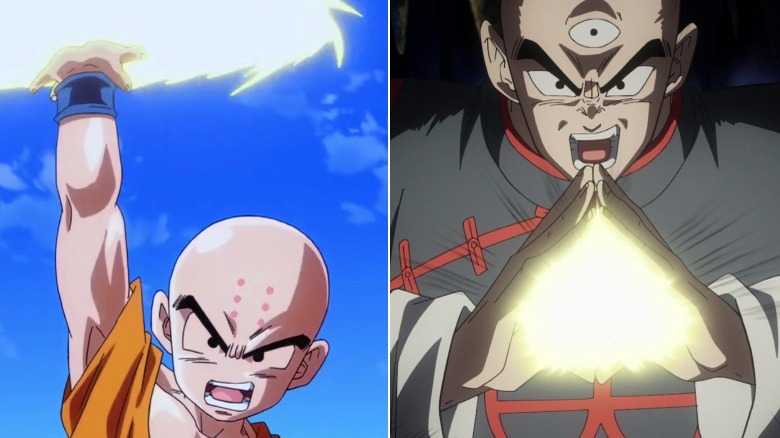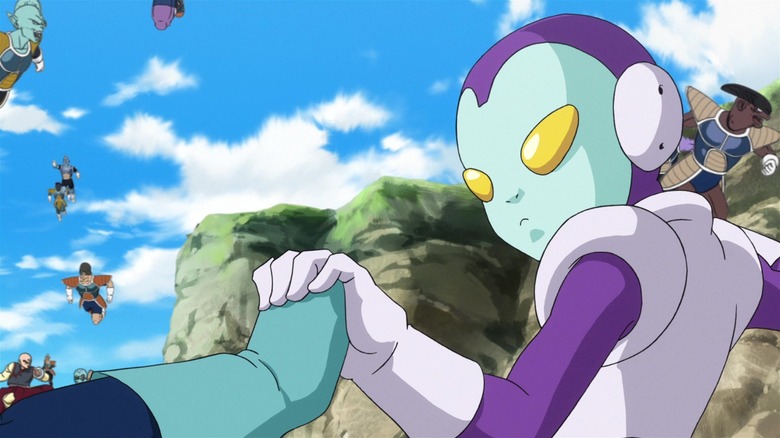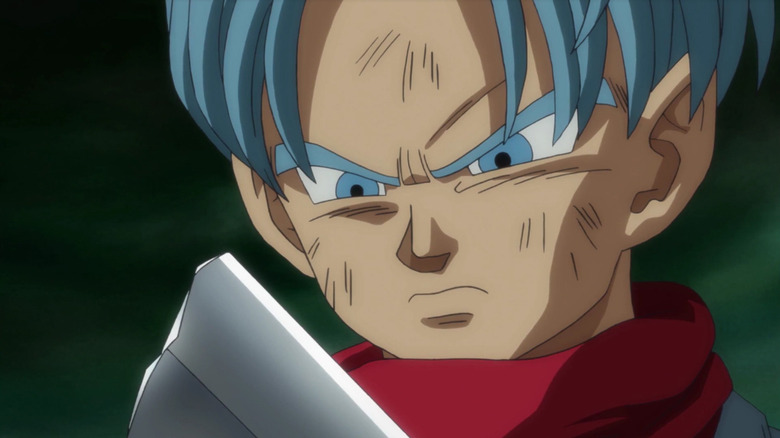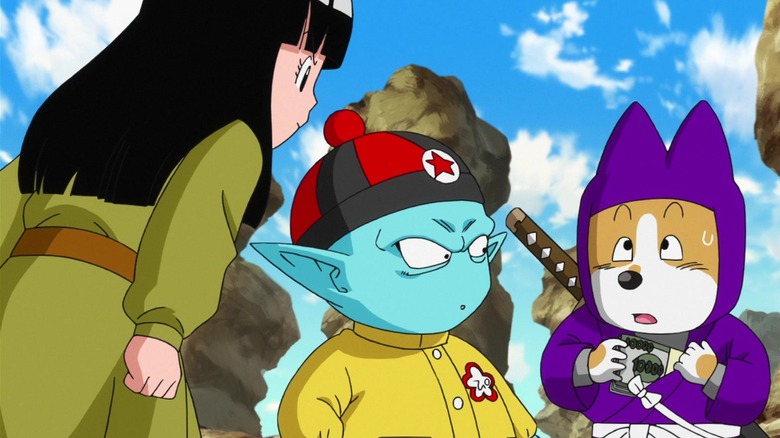The Untold Truth Of Dragon Ball Z: Resurrection F
How do you follow up on having Goku battle the most powerful god in his universe? By bringing back his most infamous foe, of course. That's precisely what happens in 2015's "Dragon Ball Z: Resurrection 'F'" in which Goku, Vegeta, and their allies must contend with the resurrection of Frieza at the hands of the Pilaf Gang. Like its direct predecessor, "Battle of Gods," the movie is a pretty big deal in "Dragon Ball" lore, introducing new transformations for Goku, Vegeta, and Frieza, as well as bringing then manga-only character Jaco the Galactic Patrolman into an animated production for the first time.
If you've seen the movie, you know all this already. Yet there may still be some facts about the feature that may have even escaped the notice of Frieza himself. So power up to your final form, and crank up Maximum the Hormone, because it's time to explore the untold truth of "Dragon Ball Z: Resurrection 'F'."
It all started with a song
There's a great "Dragon Ball" scene in "Resurrection 'F'" where Frieza's body is put back together, punctuated with some pretty head-banging music courtesy of heavy metal band Maximum the Hormone. Fittingly titled "F," the song recaps the events that take place when Frieza and his forces invade Namek in "Dragon Ball Z" in a way that parallels similar happenings in Tibet, as explained in the liner notes of Yoshū Fukushū, the album where the song appears (via Kanzenshuu).
As it turns out, "F" resonated quite a bit with "Dragon Ball" creator Akira Toriyama, who told V-Jump that upon hearing it, he decided that it was time for the "Dragon Ball Z" heroes and Frieza to have a little reunion. To express his gratitude, Toriyama not only named the movie after the song, but also added something extra to his signature when meeting the band in person: a sketch of Frieza himself.
The script won over Toriyama's toughest editor
Kazuhiko Torishima is a legend in the manga and anime world, known for shaping many big-name franchises — as well as for having been one of the tougher editors to please during his days on "Weekly Shonen Jump." As editor of Toriyama's early work, Torishima contributed many key ideas to "Dragon Ball," even playing a huge hand in its creation by suggesting Toriyama follow up on his last manga, "Dr. Slump," with a martial arts one inspired by "Journey to the West." However, his habit of turning down so many of Toriyama's ideas would lead the manga author to have a little fun at Torishima's expense, including basing "Dr. Slump" villain Dr. Mashirito on him, as Torishima explained to Forbes.
Luckily, Toriyama's script was even able to impress his old editor's critical eye, particularly when it came to the action sequences. As he gushed to V-Jump, via Kanzenshuu, "Even my very first editor Mashirito, who rarely ever praises me, said, 'This is good!'," jokingly referring to Torishima as the "Dr. Slump" foe he inspired.
It makes new revelations about Dende's Shenron
Shenron, the main mystical dragon of the "Dragon Ball" franchise, has a pretty impressive range when it comes to granting wishes. When bonded to his creator Kami, however, he also has some very real limitations. He never repeats a wish, only resurrects beings dead within the past year, and doesn't take the lives of anybody stronger than Kami. Perhaps most famously, he is only capable of fulfilling a single wish a year. These limits all seem to be due to Kami's power, rather than rules Kami has imposed on Shenron.
Shenron gets a bit of a power-up, however, when Dende takes Kami's place just before the Cell Games in the "Dragon Ball Z" series. While linked to Dende, Shenron can instead make three wishes come true when called forth, although major requests like resurrecting many people at once can use up two wishes, instead of one. Otherwise, many of Shenron's old limitations seem to be the same. "Resurrection 'F'," however, proves that Dende's custodianship of the dragon has actually lifted another old limitation, as Shenron successfully brings back Frieza, who was killed far more than a year earlier. Naturally, this suggests other villains — not to mention heroes — who've never been wished back by Shenron before may also be able to be revived. Could the return of the original Cell or Kid Buu be in "Dragon Ball Super's" future?
It's the first time Akira Toriyama's depicted Hell
Loyal viewers of the "Dragon Ball Z" anime are well familiar with the show's depiction of the afterlife, known in the Funimation English dub as Other World. There's the Check-In Station, run by King Yemma, as well as the planets of the Kais and the Supreme Kais. There's also Hell, called the HFIL (Home for Infinite Losers) in the dub, where many villains of "Dragon Ball Z" past have been banished. Most scenes in the HFIL tend to feature several "DBZ" enemies together, often either stirring up trouble for their ogre wardens (including Goz and Mez) or disdainfully watching Goku's exploits.
What people only familiar with "Dragon Ball Z" as an anime might not know, however, is that Hell is one of the afterlife locations that never appears in the original "Dragon Ball" manga. As a result, Toriyama had never shown what his take on the realm would be like. "Resurrection 'F'" remedies this, as the Dragon Ball creator finally reveals his vision of Hell, and it's a little different than how the anime depicts it. Rather than ogres guarding the place, Hell's overseers are winged beings and giant living stuffed animals who dance and play cheerful music — which, for folks like Frieza, is absolute torture. Villains are usually kept in cocoons, rather than cells, and it's implied there's a different Hell per planet, as Frieza specifically states he's in the Earth's Hell.
The pop band that's in the movie
While Maximum the Hormone's "F" prominently plays in the film, there's another major music band with a song in there — and with roles in the movie, to boot. Famed pop star group Momoiro Clover Z, who has contributed music to various animes like "Sailor Moon Crystal," sing the end credits scene "Pledge of Z" and voice the angels who watch guard over Frieza in Earth's Hell (via Anime News Network). One could see the band's participation as their way of giving back to the franchise, as member Kanako Momota revealed in the May 2015 issue of Entermix magazine, the "Z" in Momoiro Clover Z is indeed a homage to "Dragon Ball Z" (via Kanzenshuu).
The group's performers are no strangers to bringing "Dragon Ball Z" characters to life, frequently dressing as the characters at events and even in the trailer for the "Pledge of Z" song, where they also recreate some of the show's famous energy techniques through special effects (via YouTube).
It's the only movie without a full manga adaptation
If you're a faithful follower of the "Dragon Ball Super" anime and manga, then you know that both mediums have adapted Toriyama's first scripted "Dragon Ball Z" movie, "Battle of Gods." Yet manga readers may have noticed that the "Super" manga seems to skip right over "Resurrection 'F'," jumping from the events of "Battle of Gods" to the Tournament of Destroyers. While the events of "Resurrection 'F'" are acknowledged, they're never shown in the "Super" manga series proper.
Yet, that doesn't mean the movie didn't get a manga adaptation. Rather than be a part of the "Dragon Ball Super" series, the manga version of "Dragon Ball Z: Resurrection 'F'" was published in V-Jump a few short months before the "Super" manga began in the same magazine. The adaptation keeps the movie's name (including the "Z"), and is impressively faithful to the film, but stops right before Frieza turns into his Golden form, encouraging viewers to instead watch the rest of the story unfold on the big screen. One could easily be fooled into thinking it's a "Super" manga chapter, in fact, as co-author Toyotarō is also the artist of the "Resurrection 'F'" adaptation.
It's the first Dragon Ball movie where Chris Ayres voices Frieza
For years, the voice viewers of the U.S. "Dragon Ball Z" dub would hear whenever Frieza spoke was Linda Young (via IMDb). Also known for playing Fortuneteller Baba, Arale, and Fasha, Young voiced Frieza in most media all the way up to "Dragon Ball Z Kai," where she was replaced by actor Chris Ayres when the character appears on Namek. In a very short time, Ayres quickly won fan approval for his elegant, yet intense portrayal of the character, drawing comparisons to Frieza's Japanese actor, Ryūsei Nakao, due to their similar approaches.
While "Dragon Ball Z: Resurrection 'F'" does bring back certain actors who'd been replaced in "Kai," such as Meredith McCoy as Android 18 (who'd also returned to the character in "Battle of Gods"), "Resurrection 'F'" opts for Ayres to voice the Emperor of Evil, bringing his portrayal of the character to the cinema screen for the first time ever. Ayres would continue to portray the character for some of his appearances in "Dragon Ball Super," and also played Frieza in "Dragon Ball Super: Broly" before his passing in 2021.
It's the first time Toriyama has Frieza call Goku by his name
People can get very particular about Goku's name in "Dragon Ball." While most call him "Goku" or "Son Goku," Bulma has called him "Son-kun" since their earliest days of adventuring together. Meanwhile, Vegeta always calls Goku "Kakarot," due to his Saiyan roots, and both versions of Broly also refer to Goku by that name, albeit for different reasons.
Yet what about Frieza, a person who worked extensively with Saiyans before destroying them? For a long time, Frieza simply calls Goku nothing, not referring to him by name at all. At least, such was the case when Toriyama would write Frieza in the manga. In the anime, however, Frieza does call Goku by his Earth name, such as when the pure-hearted Saiyan arrives to stop him, King Cold, Cell, and the Ginyu Force from rampaging through Hell/HFIL, but none of those scenes were written by Toriyama.
Whether it's because Frieza doesn't view Goku as worthy of being called by name or if he simply doesn't see a need to do so is unclear. "Resurrection 'F'," however, puts an end to that tradition by having Frieza flat out say "Goku" for the first time under Toriyama's pen. Goku's definitely earned it, though it's not surprising Frieza probably sees things differently.
The real reason Goten and Trunks don't appear
Goten and Trunks quickly rise to prominence during the last stretch of "Dragon Ball Z," especially when they fight the various versions of Buu as Gotenks. They also become a major fixture in "Dragon Ball Z" movies, including somewhat in "Battle of Gods," where they help Goku become a Super Saiyan — and have a fight with Beerus that goes pretty badly for them, even though they're fused.
In "Resurrection 'F'," however, the two are a no-show when Frieza and his forces show up, with Gohan explaining the news would bring out their impulsive side. While the move perplexed some fans regardless, Toriyama offers an additional answer in his comments for the film's script, which was included in the movie's Japanese home release (via Kanzenshuu). Essentially, Toriyama explains, Goten and Trunks are excluded from the fight because "everyone didn't want to risk losing the next generation of warriors." While this may surprise some, given how that didn't stop Gohan from taking part in fights when he was Trunks' and Goten's ages, it is, on the other hand, consistent with Goku's ongoing concern in the Buu Saga with making sure there are fighters around to succeed him. Interestingly, Goten and Trunks are added to the film's adaptation in the "Dragon Ball Super" anime, and while they don't really advance the fight in a significant way, they at least manage to attack Tagoma in a way he won't soon forget.
It has Krillin and Tien's biggest Dragon Ball Z movie victory count
Historically, "Dragon Ball Z" movies haven't been too kind to Krillin and Tien as far as their fighting performance goes. Krillin may show up in the majority of the original 13 "Dragon Ball Z" features, for instance, but his attacks are generally portrayed as ineffective, and he often ends up subdued in some slapstick manner. Tien, on the other hand, is taken a little more seriously, but only appears in two of the first string of "DBZ" films, "The Tree of Might" and "Bojack Unbound," where he's defeated quite easily by the villains.
Those movies, it's worth noting, are not written by Akira Toriyama, and were a little more limited in length and format. The story of "Resurrection 'F'," on the other hand, is all Toriyama's own, meaning the characters on the whole are portrayed more closely to how they were in the "Dragon Ball" manga. As a result, Krillin and especially Tien fight rather admirably, taking down several members of the Frieza Force — even if Krillin struggles a bit more and has a mishap with a tree. Neither of them is shown to be a match for Frieza himself, of course, but at least they're portrayed in no worse a manner than any other of the non-Saiyan heroes in the movie.
It's the second DBZ movie to introduce a new hero
Generally speaking, "Dragon Ball Z" theatrical movies take place in their own continuity, separate from that of the manga or even the anime. As a result, it's rare for them to bring in a new hero to aid the main cast in combatting a threat. The first major exception is Tapion from "DBZ" Movie 13, known stateside as "Wrath of the Dragon," who even becomes a close friend and mentor figure to Kid Trunks before the film's conclusion. One could perhaps also make the case for Icarus, a.k.a. Haiya Dragon, though he's really more of a friend to Gohan than a heroic warrior.
So it's quite a novelty that "Dragon Ball Z: Resurrection 'F'" introduces the first hero since Tapion to join the "Dragon Ball Z" gang in battle in a movie. Of course, Jaco the Galactic Patrolman isn't an entirely "new" character, as he's previously appeared in his own manga series before "Resurrection 'F'." Yet he is new to the primary "Dragon Ball Z" cast, as most of the characters he interacts with in his manga aren't "DBZ" regulars. Furthermore, unlike Tapion, Jaco actually sticks around, becoming an overall important presence in "Dragon Ball Super," despite not being as strong as many of his new Earth allies.
The extended version you might not know about
Future Trunks isn't a major "Resurrection 'F'" character, given that the character is still back in his timeline when the movie's events occur. He appears very briefly in a scene that recaps how Frieza's killed in "Dragon Ball Z," yet is otherwise absent from the film.
However, that changes when Fuji TV, the television network where "Dragon Ball" shows usually air in Japan, broadcast an extended cut of the film in 2016 (via Anime News Network). Though largely the same movie, the cut bookends the film's events with scenes of Trunks in his alternate future, which is once again in ruins, thanks this time to Goku Black. It starts with Trunks finding a book in his mom's laboratory called "Legend of Dragon Ball," which relates the story of when Frieza first fought Goku and his friends — which is also shown, albeit in abridged form, on screen. Then, after the original movie and credits air, time fast-forwards to the future again, where Goku Black finds Trunks and destroys the canisters of time machine fuel he's also discovered in Future Bulma's lab. Fortunately, Trunks himself escapes thanks to Mai temporarily obscuring Goku Black's sight with a stun grenade, and the cut ends with Future Bulma writing detailed schematics of the time machine for her present-day self's use.
It has the first successful Pilaf Gang wish
Generally speaking, you probably don't want to make any Dragon Ball wishes if you're a member of the Pilaf Gang. The comical trio has had some pretty bad luck with wishes starting all the way back in "Dragon Ball," where Pilaf's wish to rule the world is taken from him when Oolong asks Shenron for a pair of panties. The Pilaf Gang's string of wishes gone wrong continues into "Dragon Ball Z: Battle of Gods," where it's shown that their wish to restore their youth has made them much younger than they actually wanted. Even in the one major "Dragon Ball" show that isn't canon, "Dragon Ball GT," their wishes backfire, as Pilaf accidentally wishes that Goku turn back into a kid.
"Resurrection 'F'" finally cuts the Pilaf Gang a break — sort of. After they help the Frieza Force track down Earth's Dragon Balls so Sorbet can ask Shenron to restore Frieza, Shu decides to use the next wish to snag himself a little cash — one million zeni, to be precise. It's still not the most successful wish, as Mai points out that Shu could have easily asked for a much higher amount, yet it at least seems enough to pay for a pretty decent meal. "Dragon Ball Super's" adaptation of the movie adds an extra successful wish for the Pilaf Gang, as Mai spends the dragon's third wish (which Shenron curiously does not offer in the film) on ice cream, with Shenron even adding in some ice as a courtesy to keep the treat cool.
